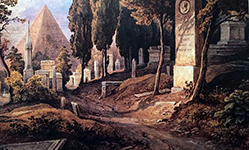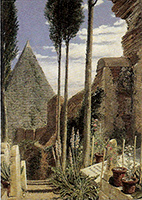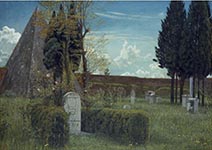|

 
Celebrazione nel 2016: RASSEGNA STAMPA E PROMOZIONE
Recensioni
Am
Fuße der Pyramide : 300 Jahre Friedhof für Ausländer in Rom
Friedhof
und Denkmal, Zeitschrift für Sepulkralkultur, 62
(2017), 45-46 (in tedesco)
Isabel von Papen
Review 'At the foot of the Pyramid. 300 years of the cemetery for foreigners
in Rome’ Casa di Goethe, Rome'
The BRITISH ART Journal, Volume XVII, No. 3
Jonathan Yarker
300
Jahre Nicht-katholischer Friedhof in Rom – Ausstellung bis zum
13. November im Goethehaus, »Der schönste und würdevollste
Friedhof, den ich je erblickte…«
L’Osservatore
Romano, Wochenausgabe in deutscher Sprache, 4. November 2016 /
Nummer 44
Christa Langen-Peduto
Schöner
sterben
Tagesspiegel.de/Kultur,
NR. 22 925, Montag, 31 Oktober 2016
Peter von Becker
Ort
des Friedens in der hektischen Stadt.
ORF.at, 31 Oktober 2016 [LINK] [PDF]
English version
posted at www.storia.at [LINK] [PDF]
Christina Höfferer
Tristo
let nekatoliškega pokopališča v Rimu'
(Three hundred years of the Non-Catholic cemetery in Rome)
Television
broadcast on Channel 1 of RTV Slovenia, Sunday 30 October 2016
(length 3 min. 40 secs.)
Janko Petrovec
Il
cimitero che da 300 anni conquista artisti e poeti.
La Repubblica, Venerdi, 28 ottobre 2016
Paola Sorge
Ai
piedi della Piramide
La
nuova Voce, 18 Ottobre 2016
Paola Pariset
Kennst
du das Grab, wo die Zitronen blühn
Süddeutsche
Zeitung, 18 Oktober 2016
Thomas Steinfeld
Kennst
du das Grab, wo die Zitronen blühn
(Conosci la tomba dove fioriscono i limoni)
Süddeutsche
Zeitung, 18 ottobre 2016
Versione italiana del articolo di Thomas Steinfeld
(sopra), traduzione di Paolo Scotini
Romantiche
memorie beat
La Repubblica, arte, 13 ottobre 2016 [LINK] [PDF]
Mariasole Garacci
Salon
der toten Künstler: Letzte Ruhe neben der Pyramide: Eine Ausstellung
zum römischen
„Cimiterio acattolico" in der Casa di Goethe
Frankfurter Allgemeine Zeitung, 12 Oktober 2016
Jörg Bremer
Friends
re-united in a Roman cemetery
Real Democracy Movement,
11 October 2016
Corinna Lotz
Roma,
trecento anni ai piedi della Piramide Cestia
Il Giornale dell’Arte,
edizione online, 3 ottobre 2016
Federico Castelli Gattinara
Shadows
of Roman non-catholic cemetery exhibition
The Italian Insider, 28 September
2016
Margaret Stenhouse
Promozione
Deutschlandfunk, 18.10.2016
"Der Friedhof für Nichtkatholiken" [Audio
- die komplette Sendung Mittwoch 7.09.2016]
Thomas Migge
Der Cimitero Acattolico ist ein ganz besonderer
römischer
Friedhof. Er ist der einzige in Rom, wo nichtkatholische Ausländer
begraben wurden - und zwar schon seit 300 Jahren. Und: Er ist einer
der schönsten und stillsten Orte der italienischen Metropole.
Das deutsche Museum Casa di Goethe in Rom zeigt Ende September
eine Ausstellung über diesen Friedhof.
La Gazzetta
dell’Antiquariato, Anno XXII,
n. 249, ottobre 2016
 "All’ombra della Piramide: I 300 anni
del Cimitero Acattolico di Roma" "All’ombra della Piramide: I 300 anni
del Cimitero Acattolico di Roma"
Marco Boni
Dal 1716 stranieri non cattolici morti
in Italia hanno trovato posto accanto alla piramide Cestia, nel Cimitero
acattolico che ancora oggi è luogo di culto e di visita culturale.
Molti di essi erano noti letterati e artisti che risiedevano in città,
altri erano visitatori occasionali, altri ancora si trovavano in
Italia per ammirarne le bellezze.
ANSA
Lifestyle, 09/2016
"Rose, marmo e silenzio, compie 300 anni il cimitero
acattolico di Roma: Tra le tombe di Keats e Gramsci, una storia
sconosciuta"
Agnese Ferrara
Già angolo magico e sorprendentemente silenzioso in cui passeggiare,
nonostante si trovi affianco ad una delle piazze più trafficate di
Roma, il cimitero acattolico di Roma sorge ai piedi della Piramide
Cestia e questo anno compie 300 anni. Poco noto ai romani che lo
confondono perfino con il vicino cimitero di Guerra del Commonwealth
e lo chiamano in molti modi diversi (da cimitero degli Inglesi, a
cimitero dei protestanti a cimitero del Testaccio, o degli artisti
e dei poeti), meriterebbe più attenzione. Arriva ora l’occasione:
per la ricorrenza è stata allestita una mostra, «Ai piedi della Piramide:
i 300 anni del Cimitero per gli stranieri a Roma» dedicata alla storia
di questo luogo di straordinaria bellezza ed intensità.
Dis
Is Italië [DisIsItalie.nl], 28.9.2016
 "300 jaar begraafplaats voor buitenlanders in Rome: In 1716 werd de
eerste aan de voet van de piramide begraven" "300 jaar begraafplaats voor buitenlanders in Rome: In 1716 werd de
eerste aan de voet van de piramide begraven"
Rop Zoutberg
Buitenlanders hebben in Rome hun eigen begraafplaats.
In de schaduw van de bekende Piramide van Cestius in de hoofdstad kregen ze
hun laatste rustplaats, omdat ze niet op de katholieke kerkhoven mochten liggen.
Dit jaar is het driehonderd jaar geleden dat de eerste buitenlander op de begraafplaats
voor buitenlanders in Rome werd begraven. [video]
Südwest
Presse, 23.09.2016
"300 Jahre protestantischer
Friedhof"
Ehinger Tagblatt
Für viele ist er einer der romantischsten
Orte Roms: Der 300 Jahre alte protestantische Friedhof inmitten
alter Bäume. Hier liegen die Gräber von John Keats, Gottfried
Semper und Goethes Sohn August. Zum Jubiläum öffnet
am Freitag eine Ausstellung.
Frankfurter Allgemeine Zeitung, 22.09.2106
"Die Vergangenheit aber dauert ewig"
Andreas Schlüter
Der Cimitero Acattolico in Rom wird dreihundert
Jahre alt: Ein fröhlicher Spaziergang im Schatten des Todes.
Il Messaggero, 18 settembre 2016
"I 300 anni dell'ultima dimora di Keats, Gadda e Pontecorvo"
Federico Guiglia
Dal 22 settembre la mostra "Ai piedi della
Piramide" per celebrare il cimitero acattolico di Testaccio.
Quotidiane
d’Arte, Mercoledì 07
settembre 2016
"Cimitero Acattolico di Roma: un sito straordinario con
una storia lunga 300 anni"
Laura Gigliotti
Fra i tanti luoghi di Roma che conservano
un particolare fascino, il Cimitero Acattolico, più conosciuto come Cimitero degli inglesi, è uno dei più segreti. Eppure è in città, circondato dalle costruzioni e dal traffico. Che non si sente più una
volta varcato il cancello, scomparso quasi per incanto.
 Wanted in Rome, No. 9 / September 2016
Wanted in Rome, No. 9 / September 2016
"At the Foot of the Pyramid"
Nicholas Stanley-Price
The
exhibition, which runs from 23 September to 13 November, presents
a short historical survey of how visual artists have responded to
the burial-ground where, for 300 years, non-Catholic foreigners have
been laid to rest. Many of the loans have not been shown before in
Rome and never together in one venue. All but one of the 43 paintings,
drawings and prints date from the 18th and 19th centuries. The exception
is strikingly different, an oil painting of his uncle’s grave
made by Edvard Munch during his visit to the city in 1927.
AsKI
KULTUR lebendig 1, 09/2016
"Casa di Goethe, Rom: Am Fuße der Pyramide. 300 Jahre ‘Friedhof
für Ausländer‘ in
Rom"
Im
Jahr 2016 wird der „Cimitero Acattolico" in Rom (jetzt offiziell „Friedhof
für Nicht-Katholische Ausländer in Rom") sein 300.
Friedhof, der auch heute noch als Begräbnisstätte dient, zieht
Tausende von Besuchern in seinen Bann. Sie kommen nicht nur aus historischem
Interesse, sondern auch, um die Schönheit dieses ruhigen, grünen
Ortes inmitten der aurelianischen Stadtmauern zu genießen. Zum ersten
Mal wird eine Ausstellung einen Überblick darüber vermitteln, wie
europäische und amerikanische Künstler unterschiedlicher Epochen
den Friedhof in Gemälden, Zeichnungen und Druckgraphiken dargestellt
haben.
Antiquariato, Mostre
Ricorrenze
"Ai Piedi della Piramide"
Paola Biondi
Per i 300 anni del Cimitero acattolico di Roma, alla Casa di Goethe
sono esposte le opere degli artisit che lo hanno raffigurato.
Corriere
della Sera, 2 settembre 2016
"All'ombra della Piramide"
Pietro Lanzara
Dal 22 settembre saranno esposti
documenti e opere sui 300 anni del Cimitero acattolico.
L’Osservatore
Romano, 24 agosto 2016
"Una primizia nella Casa di Goethe"
Solène Tadié
A Roma, per celebrare i trecento anni del
cimitero per gli stranieri alla Piramide, opere
di grandissimo valore — molte delle quali
per la prima volta in Italia — saranno esposte
all’inizio dell’autunno nella Casa romana
di Goethe.
APOLLO,
The International Art Magazine, July/August 2016
"There is still much to learn about this unusual haven in Rome"
Nicholas Stanley-Price
I suppose it was the sheer beauty of the
place, a green oasis of peace in the heart of Rome, that first
appealed to me. Only gradually did its history, as a microcosm
of the foreign community in Italy, also fascinate me. The place
is the Protestant cemetery, still in use and nowadays called more
accurately, if awkwardly, the Non-Catholic Cemetery.
| 
 "All’ombra della Piramide: I 300 anni
del Cimitero Acattolico di Roma"
"All’ombra della Piramide: I 300 anni
del Cimitero Acattolico di Roma"  "300 jaar begraafplaats voor buitenlanders in Rome: In 1716 werd de
eerste aan de voet van de piramide begraven"
"300 jaar begraafplaats voor buitenlanders in Rome: In 1716 werd de
eerste aan de voet van de piramide begraven"  Wanted in Rome, No. 9 / September 2016
Wanted in Rome, No. 9 / September 2016